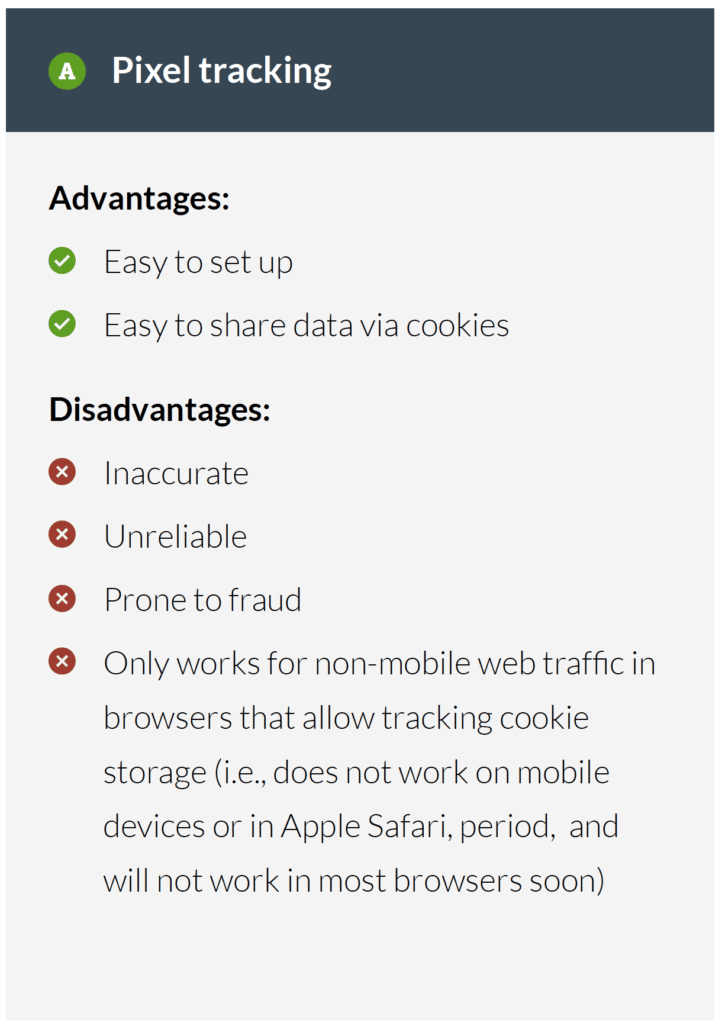
Tracking conversions. It’s essential to performance marketing, and it’s the backbone of digital advertising campaigns. But it’s not as simple as picking pixels versus postbacks. There are multiple tracking methods to choose from; each one has strengths and weaknesses, and they all vary in the channels they can handle and the technical resources they require. Choosing the right tracking methods, and using them effectively, is not as easy as it may seem.
Today, I’m excited to kick off a blog series based on our new white paper, How to Become a Track Star: Your Guide to Tracking for Performance Marketing Campaigns. In this series, we’re exploring four tracking methods from the white paper: pixel tracking, postback tracking, JavaScript SDK tracking, and clickless tracking. Each post will highlight one of these methods, summarize its most important capabilities, and present marketers with practical applications and why they work (or don’t).
First up: pixel tracking.
What Is Pixel Tracking?
Also called client-side, cookie-based, and in-browser tracking, pixel tracking is one of the oldest and most widely used forms of conversion tracking. It’s simple (as far as tracking technology goes), easy to implement, and makes data sharing a breeze. All you need to make it work is a snippet of code and an analytics tool, like Google Analytics.

For these reasons, pixel tracking became the way for advertisers, retailers, affiliates, and everyone else to measure their conversions online. Unfortunately, that popularity is now putting millions of campaigns at risk as browsers cut off the mechanics needed for this tracking method to function.
Pixel Tracking Capabilities
The beauty of pixel tracking is the same as its downfall: It doesn’t require special software, as it relies on web browsers to do the work. See this TUNE Help article for details.
For pixel tracking to function, a web browser must be able to load simple HTML containers and accept third-party tracking cookies. This wasn’t a problem until the last few years, when major browsers (including Apple’s Safari and Mozilla’s Firefox) began to block third-party cookies by default. Because it relies on these web browsers to function, any browser that blocks third-party tracking cookies now breaks all pixel tracking in that browser.
The bottom line?
Pixel tracking no longer works in Apple’s Safari browser or Mozilla’s Firefox browser, and soon, it will not work in Google’s Chrome browser, either.
In other words, unsecured, client-side session tracking is dead.
When to Use Pixel Tracking
At TUNE, our general recommendation for this tracking method is to avoid it, and if that’s not feasible, then to use it as little as possible. This is because it comes with a host of other issues, in addition to outright failing in browsers that block tracking cookies.

One of the most worrying issues is this: Pixel tracking only works for desktop web traffic. That means if everything works as it should, this method still misses 100% of conversions on mobile.
Here’s another issue, which we touched on above: Pixel tracking only works for desktop web traffic in browsers that allow tracking cookie storage.
That means today, pixel tracking misses 100% of conversions in updated Safari and Firefox browsers, as they both block third-party cookies by default. And Google Chrome, the desktop browser with 70% market share worldwide, has announced plans to end support for third-party cookies by 2022. The way things are going, soon pixel tracking may miss nearly 100% of conversions on desktop, too.
To reiterate: Avoid pixel tracking when possible. If you’re desperate, or if you don’t care about mobile, or if your customers are exclusively Chrome users who avoid Incognito mode … then only consider it as the last resort.
As a last resort, use pixel tracking if all the following are true:
- Your partners are unable to send server-side conversion notifications.
- Your promotions do not involve mobile app installs.
- Your target audience uses web browsers that support tracking-related cookies.
In Conclusion
In the white paper, How to Become a Track Star, we talk about conversion tracking in terms of campaign health. If your tracking is strong, your campaign will be healthy. If your tracking is weak, your campaign is less effective and more susceptible to harm. It’s our way of making a dense, technical, often confusing subject a little more fun — while still getting the important bits across.
When it comes to pixel tracking, the writing is on the wall. It had a good run, but the days when this method could be trusted to track online conversions are gone. Third-party cookies are on the way out; holding on will only make it harder for you to switch to a more reliable tracking method in a couple years, when Chrome joins the other major browsers in blocking third-party cookies by default.
So, if pixel tracking is out, what other options do marketers have to track conversions? We’ll cover one of the most accurate, reliable, and granular methods available today in Part 2: postback tracking.
Stay tuned!

While you’re here, check out the rest of our How to Become a Track Star series, where we cover the pros and cons of four popular tracking methods for affiliate programs and performance marketing campaigns.
- Part 1: Pixel Tracking
- Part 2: Server Postback Tracking
- Part 3: JavaScript SDK Tracking
- Part 4: Clickless Tracking
If you’re ready to get your own affiliate program started, request a trial of the TUNE Partner Marketing Platform.
Author
Becky is the Senior Content Marketing Manager at TUNE. Before TUNE, she handled content strategy and marketing communications at several tech startups in the Bay Area. Becky received her bachelor's degree in English from Wake Forest University. After a decade in San Francisco and Seattle, she has returned home to Charleston, SC, where you can find her strolling through Hampton Park with her pup and enjoying the simple things between adventures with friends and family.




Leave a Reply
You must be logged in to post a comment.